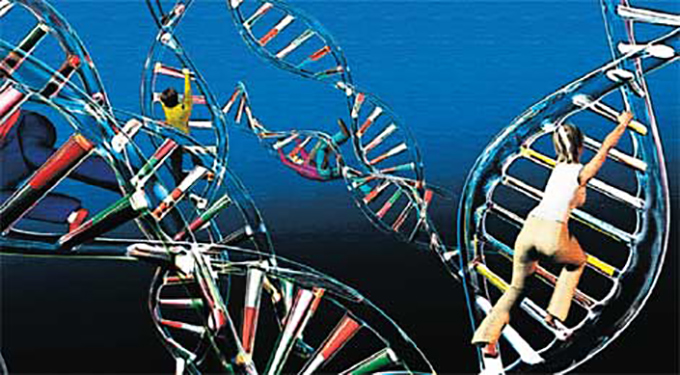
When humans’ genetic information (known as the genome) was mapped 15 years ago, it promised to change the world. Optimists anticipated an era in which all genetic diseases would be eradicated. Pessimists feared widespread genetic discrimination. Neither of these hopes and fears have been realised.
The reason for this is simple: our genome is complex. Being able to locate specific differences in the genome is only a very small part of understanding how these genetic variants actually work to produce the traits we see. Unfortunately, few people understand just how complex genetics really is. And as more and more products and services start to use genetic data, there’s a danger that this lack of understanding could lead people to make some very bad decisions.
At school we are taught that there is a dominant gene for brown eyes and a recessive one for blue. In reality, there are almost no human traits that are passed from generation to generation in such a straightforward way. Most traits, eye colour included, develop under the influence of several genes, each with its own small effect.
What’s more, each gene contributes to many different traits, a concept called pleiotropy. For example, genetic variants associated with autism have also been linked with schizophrenia. When a gene relates to one trait in a positive way (producing a healthy heart, say) but another in a negative way (perhaps increasing the risk of macular degeneration in the eye), it is known as antagonistic pleiotropy.

There’s no single gene for eye colour. Shutterstock
As computing power has increased, scientists have been able to link many individual molecular differences in DNA with specific human characteristics, including behavioural traits such as educational attainment and psychopathy. Each of these genetic variants only explains a tiny amount of variation in a population. But when all these variants are summed together (giving what’s known as a characteristic’s polygenic score) they begin to explain more and more of the differences we see in the people around us. And with a lack of genetic knowledge, that’s where things start to be misunderstood.
For example, we could sequence the DNA of a newborn child, calculate their polygenic score for academic achievement and use it to predict, with some degree of accuracy, how well they will do in school. Genetic information may be the strongest and most precise predictor of a child’s strengths and weaknesses. Using genetic data could allow us to more effectively personalise education and target resources to those children most in need.
But this would only work if parents, teachers and policymakers have enough understanding of genetics to correctly use the information. Genetic effects can be prevented or enhanced by changing a person’s environment, including by providing educational opportunity and choice. The misplaced view that genetic influences are fixed could lead to a system in which children are permanently separated into grades based on their DNA and not given the right support for their actual abilities.
Better medical knowledge
In a medical context, people are likely to be given advice and guidance about genetics by a doctor or other professional. But even with such help, people who have better genetic knowledge will benefit more and will be able to make more informed decisions about their own health, family planning, and health of their relatives. People are already confronted with offers to undergo costly genetic testing and gene-based treatments for cancer. Understanding genetics could help them avoid pursuing treatments that aren’t actually suitable in their case.
It is now possible to edit the human genome directly using a technique called CRISPR. Even though such genetic modification techniques are regulated, the relative simplicity of CRISPR means that biohackers are already using it to edit their own genomes, for example, to enhance muscle tissue or treat HIV.
Such biohacking services are very likely to be made available to buy (even if illegally). But as we know from our explanation of pleiotropy, changing one gene in a positive way could also have catastrophic unintended consequences. Even a broad understanding of this could save would-be biohackers from making a very costly and even potentially fatal mistake.

Biohackers may try to enhance their bodies with altered DNA. Shutterstock
When we don’t have medical professionals to guide us, we become even more vulnerable to potential genetic misinformation. For example, Marmite recently ran an ad campaign offering a genetic test to see if you either love or hate Marmite, at a cost of £89.99. While witty and whimsical, this campaign also has several problems.
First, Marmite preference, just like any complex trait, is influenced by complex interactions between genes and environments and is far from determined at birth. At best, a test like this can only say that you are more likely to like Marmite, and it will have a great deal of error in that prediction.
Second, the ad campaign shows a young man seemingly “coming out” to his father as a Marmite lover. This apparent analogy to sexual orientation could arguably perpetuate the outdated and dangerous notion of “the gay gene”, or indeed the idea that there is any single gene for complex traits. Having a good level of genetic knowledge will enable people to better question advertising and media campaigns, and potentially save them from wasting their money.
My own research has shown that even the well-educated amongst us have poor genetic knowledge. People are not empowered to make informed decisions or to engage in fair and productive public discussions and to make their voices heard. Accurate information about genetics needs to be widely available and more routinely taught. In particular, it needs to be incorporated into the training of teachers, lawyers and health care professionals who will very soon be faced with genetic information in their day-to-day work.
Author Bio: Robert Chapman is a PhD Candidate, Goldsmiths at the University of London
